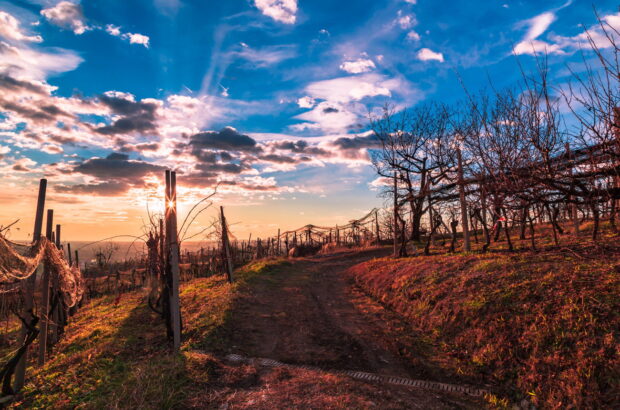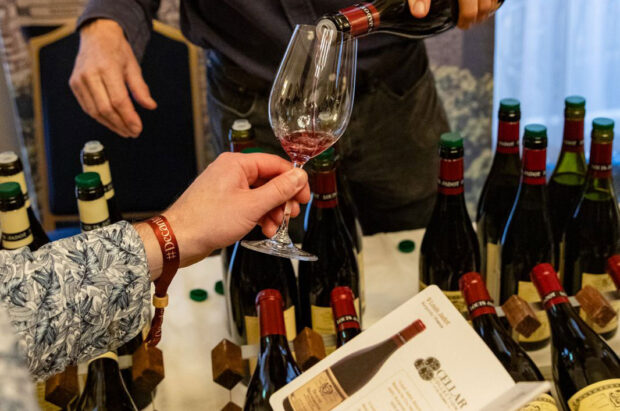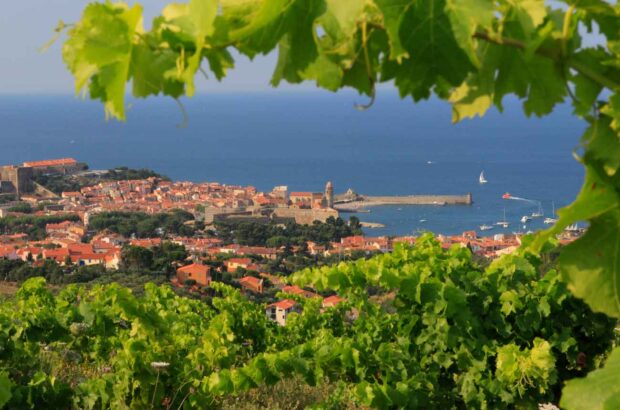In partnership with Wines of Hungary
Volcanism over aeons of history has shaped much of Hungary’s landscape, although this explosive period came to an end around two million years ago. Its legacy is a beautiful landscape of rolling hills, caves and natural hot springs for visitors to explore.
An overview
The ancient Pannonian Sea covered much of Hungary until 5.5 million years ago, so much of the earliest volcanic activity took place underwater. The retreating sea left behind marine sediments, which mingled with igneous rocks (those resulting from volcanic processes) to create a complex mosaic of rock types. The volcanic bedrock is peppered with outcrops of limestone and schist, and topped by soils of clay, sand and fine wind-blown loess. What does this mean for wine drinkers today? These volcanic soils leave their unmistakable signature of salinity and vibrant freshness on the regions’ wines.
Hungary’s volcanic soils (discussed in more detail below) are all home to high-quality wines, but each region has its own volcanic character: Lake Balaton’s basalts are harder, while those on the Tihany peninsula are more alkaline, and Somló is home to porous mineral basalts. Mátra’s soils are mainly andesite, contrasting with neighbouring Eger and Bükk’s rhyolite soils. Meanwhile, the hills of Tokaj, that storied volcanic region, are a supremely complex mix. While all these regions share a volcanic inheritance, it is the fascinating nuances of their different soils that set the stage for the rich variety of Hungarian wines.

A steep volcanic ‘witness mountain’ by the shores of Lake Balaton. Credit: Wines of Hungary
Around Lake Balaton – southwest of Budapest
Some of Hungary’s most picturesque and welcoming wine regions are found around the warm turquoise waters of Lake Balaton, the largest lake in Central Europe. There’s a mild Mediterranean vibe to the climate, making it a popular holiday spot for swimming, sailing and walks or bike rides into the surrounding national park.
The soils
The northern shore of Lake Balaton is the site of a chain of volcanoes that erupted around three to four million years ago. The most important volcanic regions here include Balaton-Felvidek (Balaton Highlands) and Badacsony. Balatonfüred-Csopak also boasts a small volcanic area, on the scenic Tihany peninsula on the lake’s northern edge.
Badacsony takes its name from the impressive hill on the lake’s shore – a distinctive type of flat-topped volcanic cone known as a ‘witness mountain’. After millions of years of erosion, only the hard basalt core remains, leaving a strikingly shaped pedestal overlooking the surrounding plains.
The area also covers 10 other hills, most notably Szent György-Hegy, Csobánc and Szigliget. These inland peaks have different basalt-based soils, and a cooler climate, as they are further from the sunny reflections from the lake. This gives their wines a more linear, vibrant structure. Leading wine producers in Badacsony include Villa Tolnay, Laposa, Sabar, Földi Bálint, Szászi, UJVARI and Borbély.

The Káli Basin, in the Balaton Highlands region. Credit: Wines of Hungary
Key grape varieties
White wines dominate here, with Olaszrizling in the starring role. After Furmint, this is Hungary’s second most important white grape, and may be the best white grape you’ve never heard of – because it hides under so many identities (Graševina in Croatia, Laški Rizling in Slovenia and Welschriesling in Austria). In the past, Olaszrizling was dismissed as only fit for low-quality wine, to be used in the ever-popular Fröccs spritzers.
But with care and attention, this grape variety is capable of exciting quality, from zesty, fruity reductive styles to layered and intense age-worthy wines – and is well-suited to volcanic soils. Expect pear, lemon and pineapple with a touch of fennel and almond, sometimes honey, backed by supple acidity and a mineral firmness.
Other important grapes include the rare Kéknyelű variety, whose name means ‘blue stem’. This white grape has a long history in the area, but almost disappeared thanks to its low yields. Today it is having a renaissance as wineries realise its potential for flinty, stone-fruited, firm-textured wines that can repay ageing. Pinot Gris (known in Hungary as Szürkebarát, meaning ‘grey monk’) also thrives on these sunny basalt soils, resulting in rich yet mineral styles.
Furmint used to be widely planted across Hungary, but has only recently been reestablished in this region, led by the visionary Canadian winemaker Robert Gilvesy on the slopes of the famous hill Szent György-hegy. Balaton Furmint has a distinctly different style to that of Tokaj: broader, with stone fruit and apple notes, and more supple acidity paired with mineral grip.
There are also a few reds – Gilvesy has planted Kadarka in Badacsony. Kékfrankos, meanwhile, is ideally suited to the volcanic caldera of the Tihany peninsula, where producers Zelna, Homola and St Donat are making impressive and delicious red wines.

Csopak, on the northern shore of Lake Balaton, is famed for its Olaszrizling. Credit: Wines of Hungary
Somló – ‘Where God forgot his hat’
North of Lake Balaton, flat plains surround the dramatic sihouette of the lonely Somló hill – affectionately known by locals as ‘the place God left his hat’.
The soils
Soils here are typically eroded basalt and tuff, less dense and more porous than the hard basalt volcanoes close to the lake. Nearer the surface, there are layers of wind-deposited loess.
Somló wines are characterised by their distinctly fiery, mineral character. No matter what grape is grown, Somló’s terroir imparts a distinctly saline, mineral and somewhat austere character. The majority of vines here are white grapes (mostly local varieties), alongside small amounts of Syrah.
Key grape varieties
Juhfark (‘sheep’s tail’) is the standout grape here. Producers had to fight to keep this ancient white variety, which was only reauthorised in the 1990s. Offering piercing acidity, stony leanness and restrained notes of citrus, grapefruit and herbs, wines made from Juhfark can age beautifully.
Other important grapes are Olaszrizling, Furmint and Hárslevelű – here always in a distinctive Somló mode: broader and more saline. Somló, a small wine region, is a land of tiny family and hobby producers, with only a few professional wineries – look out for Kolonics, Spiegelberg, Somlói Vándor and the larger Kreinbacher.
Andesite Basalt Limestone Loess Rhyolite Schist Tuff
Key Soils to know
Named after the Andes mountain range, an igneous rock midway in composition between basalt and rhyolite
A fine-grained igneous rock formed as low-silica, low-viscosity magma cools
A sedimentary rock, calcium carbonate, formed when calcium precipitates out of water
A porous soil of fine clay and silt particles deposited over time by the wind
An igneous rock, often glassy-textured, formed as the most viscous, high-silica magma cools
A flaky metamorphic rock composed of distinct mineral layers
A soft rock made of volcanic ash thrown out during an eruption

Volcanic soils are rich in key minerals. Credit: Wines of Hungary
Heading northeast: Mátra, Eger and Bükk
Achain of volcanic hills in the northeast of Hungary is also home to important wine regions: Mátra, Eger and Bükk. Mátra Heading out from Budapest, the first region you come across is Mátra: cool, hilly and sadly often overlooked in favour of its better-known neighbours, despite being one of Hungary’s largest regions.
Mátra is home to only a handful of producers, the best being small family estates such as Centurio, Benedek and N.A.G. The wines are characterised by their freshness, elegance and restraint. Production is white-led, but with 67 varieties grown in the region, there’s no real flagship. Pinot Gris/Grigio is the most planted, and the reds are led by Kékfrankos, Cabernet Sauvignon and Zweigelt.
Eger
Eger is one of Hungary’s most important and best-known wine regions – though in the past because of a somewhat infamous wine: the cheap, rustic ‘bull’s blood’. This is predominantly a region of tuff and rhyolite tuff soils, with numerous cellars carved into the hills. Vines are planted on the south-facing volcanic slopes of the Bükk Mountains, which offer protection from cold north winds in the winter, but also ensure cooling breezes in summer.
Eger’s climate is cool compared to the rest of the country, but its wines can combine elegant freshness and plush, fruit-forward styles. The town of Eger itself is well worth a visit for its Baroque architecture, hot springs and famous fortress. The region’s most iconic wine is still called Bikavér – but it has been reinvented as a flagship red blend, based on Kékfrankos, with strict rules governing yields and ageing. The aim is to showcase Eger terroir rather than individual grape varieties.
Eger also produces a white counterpart called Egri Csillag, together with distinctive expressions of international grapes, including Chardonnay and Syrah. Notable Eger producers are St Andrea, Kovács Nimród Winery, Toth Ferenc, Bolyki and Gál Tibor.

Hungary’s volcanic soils have been extensively studied. Credit: Wines of Hungary UK
Bükk
The Bükk wine region is effectivel a continuation of Eger’s geology. Its wines were once notorious for searing, tooth-hurting acidity – but in today’s climate, and with improved viticulture, this acidity is becoming a distinct advantage, creating racy, refreshing and bright wines. Although Bükk was once a supplier of grapes to other regions, it now boasts a new generation of small estates and low-intervention producers such as Gallay and Sándor Zsolt. The Zenit grape is proving particularly appealing, along with blends based on Cserszegi Fűszeres and reds from Zweigelt and Pinot Noir.
Badacsony: loess, clay and sand at lower elevations, basalt and tuff higher up Balaton Highlands and the Tihany peninsula: predominantly dense basalt Eger and Bükk: predominantly tuff and rhyolite tuff Mátra: largely andesite Somló: eroded basalt, tuff and loess Tokaj: a complex combination of andesite, rhyolite, loess and more
Hungary’s volcanic regions

Wines age in intricate networks of cellars dug into Tokaj’s hills. Credit: Wines of Hungary UK
Tokaj – Hungary’s flagship volcanic region
Hungary’s most famous region, Tokaj, may have some of the most complex geology anywhere in the wine world, with around 400 extinct volcanoes.
The soils
There are three main soil types: a red clay called nyirok, formed from degraded volcanic bedrock incorporating organic matter and iron; fine windblown loess, found mainly on the slopes of the volcanic Tokaj hill itself; and a soil known as ‘rock flour’ (derived from pumice).

Steep volcanic hillsides make for well-drained vineyards. Credit: Wines of Hungary
The wines
Today, top producers are working to better understand the individuality and potential of their soils – especially given the particular ability of the area’s leading grape, Furmint, to express terroir differences. Tokaj comprises 27 villages and 418 identified separate crus – and even within a single cru there can be significant differences.
The best producers today are exploring the unique characteristics of single vineyards (featured on labels as dűlő). The darker clays of Betsek, for example, yield more structured wines; wines from the stony soils of Úrágya are austere when young but long-lived; loess over volcanic bedrock at Kis-Garai gives more delicate ethereal aromas; while the clays of Szent Tamás produce some of the region’s top wines.
In a few cases, winemakers like Szepsy, Balassa, Demetervin and Disznókő are selecting specific parcels within a cru for their unique characteristics. Tokaj has wealth of great producers that are exploring the story of their volcanic terroir, including Szepsy, Royal Tokaji, Demeter Zoltán, Gizella, Harsányi, Füleky, TR Wines, Tokaj Nobilis, Kikelet, Demetervin and Disznókő. Vines and volcanoes come together through the lens of Hungarian wine in a glass – mineral, complex, distinctive and well worth exploring.








